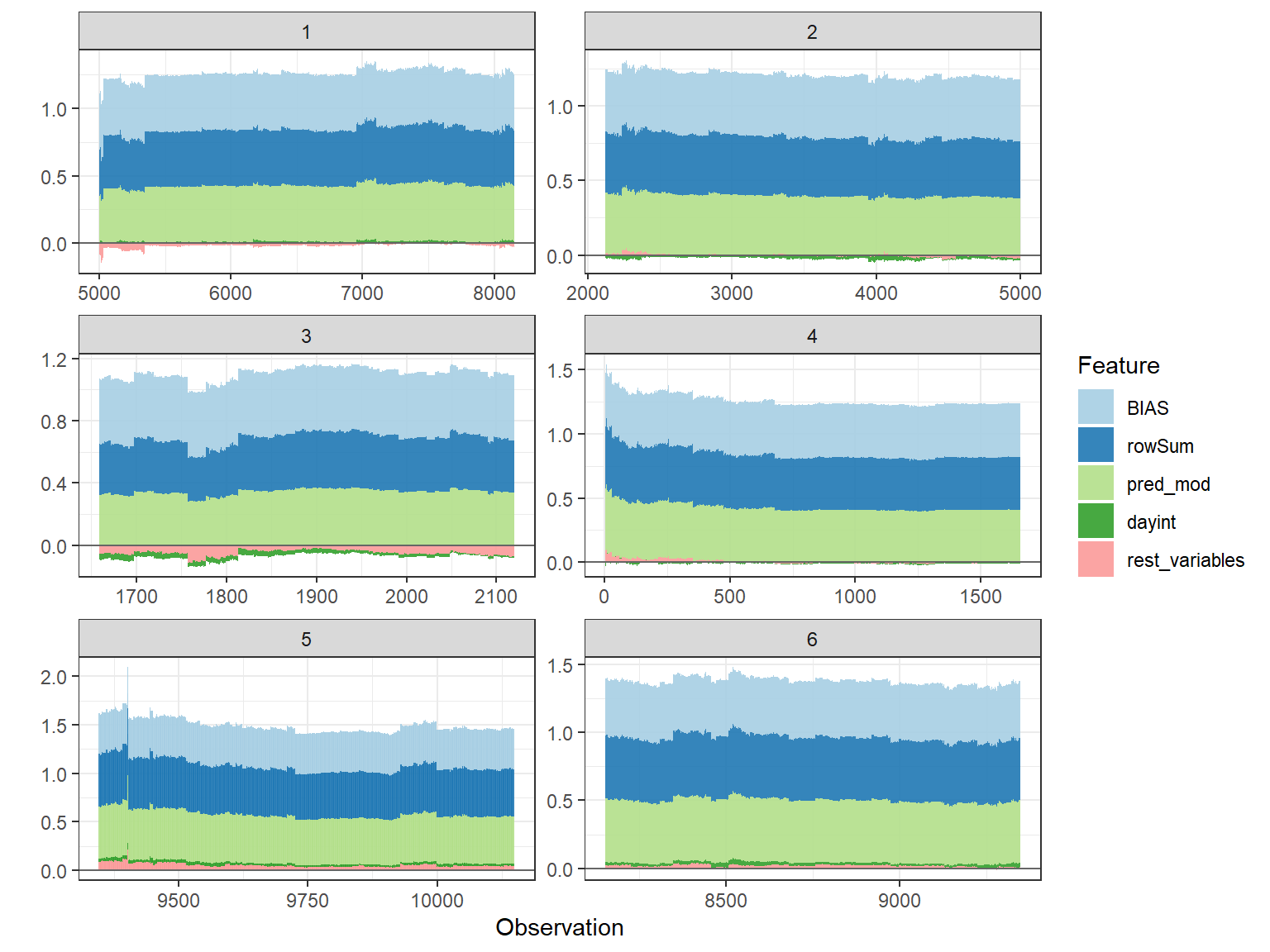This package creates SHAP (SHapley Additive exPlanation) visualization plots for 'XGBoost' in R. It provides summary plot, dependence plot, interaction plot, and force plot. It relies on the 'dmlc/xgboost' package to produce SHAP values. Please refer to 'slundberg/shap' for the original implementation of SHAP in Python.
The purpose is to create some conveniences for making these plot in R. I understand 'ggplot' is highly flexible so people always need to fine-tune here and there. But adding more flexibility just over-complicates the wrapped functions. I tried to find a balance. All the functions except force plot return ggplot object, it is possible to add more layers. The dependence plot shap.plot.dependence returns ggplot object if without the marginal histogram by default.
I have built in some default labels for feature names, you could also supply features labels as a list named new_labels, the functions will use this list and label accordingly. Another option is you can always overwrite the labels on the ggplot by adding labs layer to the ggplot object.
Please refer to this blog for more examples and discussion on SHAP values in R, why use SHAP, and comparison to Gain: SHAP visualization for XGBoost in R
Please install from github:
devtools::install_github("liuyanguu/SHAPforxgboost")You can also install the released version of plotthis from CRAN with:
install.packages("SHAPforxgboost")Summary plot
# run the model with built-in data, these codes can run directly if package installed
library("SHAPforxgboost")
y_var <- "diffcwv"
dataX <- dataXY_df[,-..y_var]
# hyperparameter tuning results
param_dart <- list(objective = "reg:linear", # For regression
nrounds = 366,
eta = 0.018,
max_depth = 10,
gamma = 0.009,
subsample = 0.98,
colsample_bytree = 0.86)
mod <- xgboost::xgboost(data = as.matrix(dataX), label = as.matrix(dataXY_df[[y_var]]),
xgb_param = param_dart, nrounds = param_dart$nrounds,
verbose = FALSE, nthread = parallel::detectCores() - 2,
early_stopping_rounds = 8)
# To return the SHAP values and ranked features by mean|SHAP|
shap_values <- shap.values(xgb_model = mod, X_train = dataX)
# The ranked features by mean |SHAP|
shap_values$mean_shap_score
# To prepare the long-format data:
shap_long <- shap.prep(xgb_model = mod, X_train = dataX)
# is the same as: using given shap_contrib
shap_long <- shap.prep(shap_contrib = shap_values$shap_score, X_train = dataX)
# (Notice that there will be a data.table warning from `melt.data.table` due to `dayint` coerced from integer to double)
# **SHAP summary plot**
shap.plot.summary(shap_long)
# sometimes for a preview, you want to plot less data to make it faster using `dilute`
shap.plot.summary(shap_long, x_bound = 1.2, dilute = 10)
# Alternatives options to make the same plot:
# option 1: start with the xgboost model
shap.plot.summary.wrap1(mod, X = as.matrix(dataX))
# option 2: supply a self-made SHAP values dataset (e.g. sometimes as output from cross-validation)
shap.plot.summary.wrap2(shap_values$shap_score, as.matrix(dataX))
Dependence plot
# **SHAP dependence plot**
# if without y, will just plot SHAP values of x vs. x
shap.plot.dependence(data_long = shap_long, x = "dayint")
# optional to color the plot by assigning `color_feature` (Fig.A)
shap.plot.dependence(data_long = shap_long, x= "dayint",
color_feature = "Column_WV")
# optional to put a different SHAP values on the y axis to view some interaction (Fig.B)
shap.plot.dependence(data_long = shap_long, x= "dayint",
y = "Column_WV", color_feature = "Column_WV")
# To make plots for a group of features:
fig_list = lapply(names(shap_values$mean_shap_score)[1:6], shap.plot.dependence,
data_long = shap_long, dilute = 5)
gridExtra::grid.arrange(grobs = fig_list, ncol = 2)
SHAP interaction plot
# prepare the data using either:
# (this step is slow since it calculates all the combinations of features. This example spends 10s.)
data_int <- shap.prep.interaction(xgb_mod = mod, X_train = as.matrix(dataX))
# or:
shap_int <- predict(mod, as.matrix(dataX), predinteraction = TRUE)
# **SHAP interaction effect plot **
shap.plot.dependence(data_long = shap_long,
data_int = shap_int,
x= "Column_WV",
y = "AOT_Uncertainty",
color_feature = "AOT_Uncertainty")
SHAP force plot
# choose to show top 4 features by setting `top_n = 4`, set 6 clustering groups.
plot_data <- shap.prep.stack.data(shap_contrib = shap_values$shap_score, top_n = 4, n_groups = 6)
# choose to zoom in at location 500, set y-axis limit using `y_parent_limit`
# it is also possible to set y-axis limit for zoom-in part alone using `y_zoomin_limit`
shap.plot.force_plot(plot_data, zoom_in_location = 500, y_parent_limit = c(-1,1))
# plot by each cluster
shap.plot.force_plot_bygroup(plot_data)
Recently submitted paper from my lab that applies these figures: Gradient Boosting Machine Learning to Improve Satellite-Derived Column Water Vapor Measurement Error
Corresponding SHAP plots package in Python: https://github.com/slundberg/shap
Paper 1. 2017 A Unified Approach to Interpreting Model Predictions
Paper 2. 2019 Consistent Individualized Feature Attribution for Tree
Ensembles
Paper 3. 2019 Explainable AI for Trees: From Local Explanations to Global Understanding




